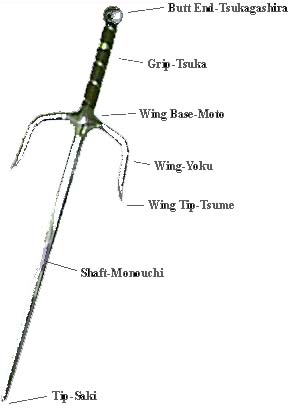|
The History of
the Chakram
The Chakram or Chakra was used mostly by the Sikhs of north west India for hundreds of years. The chakram is a flat steel quoit (ring) with a razor-sharp outer edge. The Quoit is generally 6 to 8 inches in diameter. The Sikhs became martial
under Guru Govind Singh and used the Chackra effectively against the
Moghul dynasty. The Chackrum has a history that is as old as Indian
civilization itself. It's useage is embedded in Indian myth and legend.
In the epics..the Mahabharata for instance...an asura trying to get
heavenly nectar from the moon had his head chakra-ed off. Still he
tries to swallow the moon and succeeds ever so often before the moon
escapes through the cut neck...an eclipse myth. Sculptures and paintings
of many gods and godesses show the chakra being twirled. Several quoits
were worn around a tall, conical turban and were either whirled around
the forefinger before throwing or held between the thumb and forefinger
and thrown underarm much like a frisbee. The picture above shows a
Sikh soldier spinning a chakram around his forefinger. If it is thrown correctly the target never hears or sees it. However, some of the more elaborate rings had small holes bored into them to produce a whistling sound as they spun in the air. The deep thunk of a solid hit when the chakram sticks is reward enough for the hours of practice one spends mastering this weapon. History of The
Sai
Like all the traditional
Okinawan weapons, the exact original of the sai is not known although
a few theories exist. One theory is that the sai was derived from
a type of hoe. This hoe was used to dig a furrow in the ground. At
selected points within the furrow, deeper holes were made with the
point of the hoe in which seeds were planted. Later, the hand guards
were added. A second theory is that the sai was a direct import from
China or Indonesia. This theory states that there was no Okinawan
tool upon which it was based. The rational for this theory is that
there is little iron on Okinawa which would be needed to make the
sai. Thus, the case for the sai being an import. Even though the sai are sometimes called "short swords", they were not used as a traditional sword word be. Sai were primarily a defensive weapon. They were used more as a club would be. Following are some techniques of sai use: * With the blade retracted, the
sai would cover the forearm to augment blocking techniques. Also the
butt end could be used as an effective punching implement. The prongs of the sai are good for blocking, catching and trapping bo or sword strikes. Once the prongs complete the trap, the defender can use the sai to twist the attacker's weapon from their grasp or even breaking the opponent’s weapon. Because of the flipping techniques employed in use of the sai, strong and limber wrists need to be developed if one is going to master their use. |
Anatomy of the Sai
 |
|
History of the Bo Staff The bo staff is probably
one of mankind's oldest weapons. They belong to the same family as
spears. The bo was commonly used to carry buckets of grain or water,
one on each end of the staff for balance purposes. When attacked,
the defender could easily slip the buckets off each end and have a
very handy weapon. Or staffs would be used as a walking implement.
When attacked, what seemed a harmless tool, became a deadly weapon.
The staff is nothing more than long stick. Traditionally it measured
six feet in length, but both shorter and longer versions were used
depending on the situation and practitioner. The bo staff, because of its length, was not a weapon for close in fighting. Rather it was used to defend one's self from a distance. The staff operates best from outside your opponent's attack zone. It is also most useful in relatively open spaces. The staff is best used when both hands manipulate its use. |